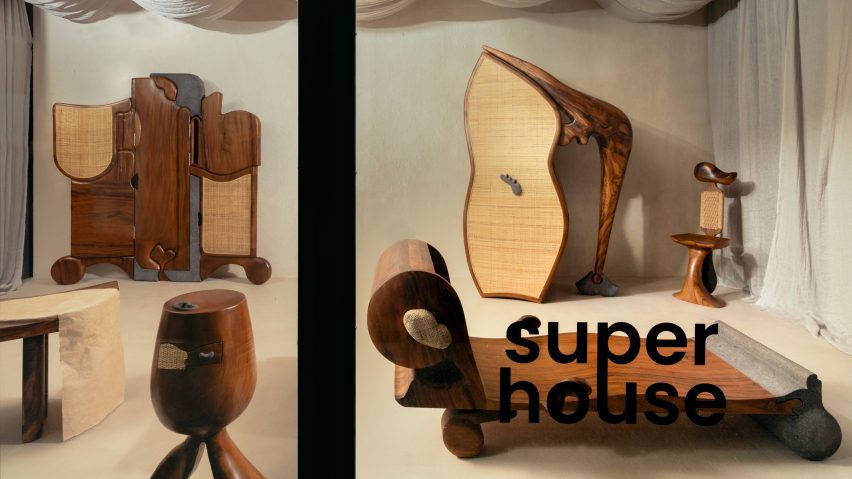Belgian interior designer Kim Mupungilaï has created a series of furniture and decor items for an exhibition in New York City using digital and traditional techniques to explore ideas of identity and appropriation.
The exhibition, called HUE/AM/I-HUE/I/AM, features chairs, tables and bureaus constructed from a mix of wood, stone and fibre elements, presented at Superhouse Vitrine in Lower Manhattan.
It is the first full collection of furniture from Mupungilaï, who said a trip to New York City in 2018 prompted thinking about the forms and ideas of identity behind the work.
"I just started thinking about my own cultural landscape and background and upbringing and wanted to dig deeper," Mupungilaï told Dezeen.
"And that kind of prompted the idea of merging or exploring my two heritages," she continued.
"I'm half Belgian, half Congolese, and I grew up in Belgium, so I never really knew a lot about my Congolese side."
This exploration included a deep dive into the artisanal forms and materials commonly used in the African nation, especially "currency tools" a type of tool or weapon used for a variety of symbolic and practical purposes.
These formed the "base of abstract forms" that Mupungilaï then converted into the furniture in the collection.
The result is a diverse mix of sculptural pieces, all with a striking mix of materials, from a sloping wooden arm that branches off the bureau and terminates in a ballpoint embedded in a stone foot to a textile derived from the banana leaf, which stretches of the seat of a wooden bench.
Teak wood, the banana, the shape of stones and the rattan are all references to what she says are unique material resources of the region.
To create the sculptural forms, Mupungilaï tests out the designs first in 3D modelling programs and then has the pieces hand constructed by fabricators abroad.
The mix of the functional and sculptural makes sense both in terms of Mupungilaï's influences as well as within the specific scene in New York around Superhouse Vitrine, a space in Lower Manhattan's Chinatown. It consists of a single glass-lined room at the centre of the second floor of a shopping mall.
Founder Stephen Markos' said that he wants to showcase what he considers art with functionality.
"People always talk about the border between art and design," Markos told Dezeen. "I don't really even think it fits on the border," he continued, referencing the totality of designers he shows at the gallery.
"I think it really skews more toward the side of art than design. I've been really focused on functionality so here's where design comes in. It's really interesting when a work of art when you can sit on a work of art."
The conceptual nature of Mupungilaï's work was also an important factor in its presentation. Since the release of some of the early pieces from the collection, such as the room divider, the designer said she has been asked often about ideas of influence and appropriation and that her work represents a place of departure for conversations around these complex topics.
"I think for a lot of people, it's hard to understand to draw a line when – does something become cultural appropriation?" Mupungilaï explained.
"I mean, you can be inspired by culture, but when you start literally extracting things from a culture without crediting or acknowledging their arts, their culture or traditions, it becomes cultural appropriation, so there's a very fine line," she continued.
"I feel like it happens so often in design, but it's not spoken about at all, or very, very rarely."
Superhouse formed part of last year's Design Miami festival, where some early pieces of HUE/AM/I-HUE/I/AM were shown. Other recent exhibitions in New York City include one by Marta Gallery that showcased chairs made from salvaged materials in just three days.
The photography is by Luis Corzo.
HUE/AM/I-HUE/I/AM is on show at Superhouse Vitrine from 28 June to 19 August 2023. For more exhibitions, events and talk in architecture and design, visit Dezeen Events Guide.

